Whether the goal is to increase sales or drive awareness, we want to deliver the right ad, to the right set of customers, and at the right moment. With greater targeting capabilities to reach audiences that have previously engaged with brands, remarketing provides this opportunity. The benefits, however, extend beyond reaching customers that have abandoned a shopping cart. Check out our new functionality to see how proper data usage, accompanied by customised ads and bid strategies will help drive sales through the roof.
Today, we are excited to introduce Remarketing in Paid Search for Bing Ads. Early participants of our pilot program have seen great returns, so we can’t wait for you to try it out. With new targeting enhancements to optimise your search campaigns, remarketing is especially fitting for advertisers looking to get the most out of the coming holiday shopping season.
What is Remarketing in Bing Ads?
Remarketing enables you to engage with visitors that have previously visited your site. In simple terms, it’s a second chance. This valuable addition to your audience targeting toolbox allows you to reconnect with users and deliver customised ads to audiences that didn’t make a final decision the first time around.

Why Use Remarketing?
If we think about user behaviour, people looking for products and services online rarely convert on their first visit. Instead we often find that customers visit a site, check out competitors, compare prices, or simply get distracted. Research shows that 96 percent of first time visitors leave websites without converting.1
Remarketing enables you to reengage either all or a subset of visitors, upsell, remain top of mind, or even cross-sell to existing customers to drive a higher ROI. First indications from advertisers report substantial gains in CTR, conversion rates and a lower cost per acquisition.
Benefits of Remarketing
Unlike traditional search campaigns where bids, ads and keywords are the same for every searcher, now you can increase your bids, display ads with a broader set of keywords, and/or target different ads to different audiences based on past activity. As users that have previously visited your site are familiar with your products and services, they are more likely to click on ads and convert, thereby increasing the ROI of your campaigns.
Remarketing can be used in two ways:
1. Make bid adjustments to ad groups for users in remarketing lists. Bid adjustments are applied when users search for keywords that the advertiser bids on. Increasing bids furthers the chance to display ads to those users.
2. Configure ad groups to trigger ads only if a user is on your remarketing list and searching for keywords that you are bidding on. Additionally, you can also expand the list of keywords for these users. This option enables you to show customised ads to users in your remarketing lists.
How to Set Up Remarketing
Getting started with remarketing is easy. We’ve mapped it out in four simple steps. For additional information and a detailed walk-through, visit our help page.

1. First, create a UET tag from Conversion Tracking > UET Tags page and install the UET tag tracking code on all pages of your website. The UET tag tracking code allows Bing Ads to collect actions people take on your website. Note that if you already have a UET tag installed on your website then you are all set. The UET tag tracking code allows Bing Ads to collect actions people take on your website. Note that if you already have the UET tag installed on your website, there’s no need to make a change.
2. Second, navigate to Shared Library > Audience page and click Add Remarketing to segment your website visitors into one or more groups (called Remarketing lists) based on pages they visited or specific actions they took on your website. For example, you can create a remarketing list for users that viewed a particular product page or for those that abandoned shopping cart. The snapshot below shows the user experience for creating a new remarketing list. Learn more about the various options during this step in the process.
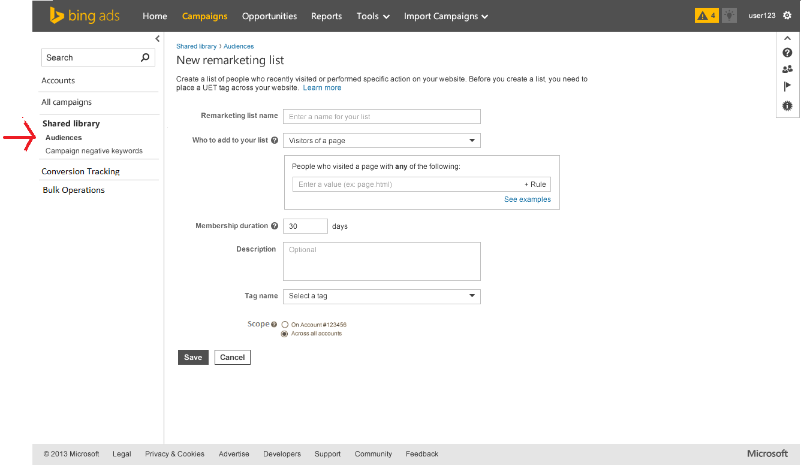
3. Once you’ve created the remarketing lists, you can adjust bids, customise ads, or expand keyword lists to target users on your remarketing lists. This can be achieved by associating the remarketing lists to ad groups. You can also create remarketing associations in bulk from the Ad Groups tab on the Campaigns page; select one or more ad groups and click on Edit>Associate with Remarketing lists.
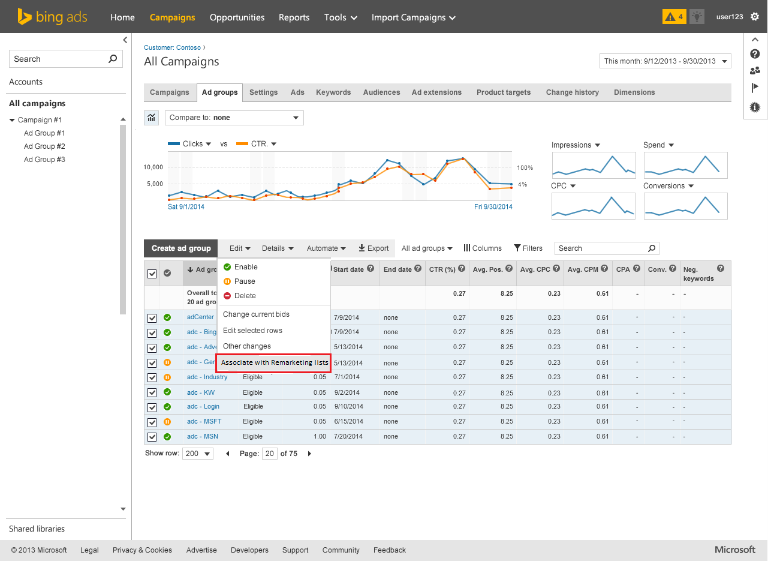
When saving the associations, there are two options for Targeting Setting:
- Bid Only allows the ad group to serve ads to all searchers in the list, and if a bid adjustment is applied (see step 4 below), the updated bid will be applied for users in the remarketing lists. This is the most commonly used setting.
- Target and Bid configures the ad group to show ads only to users in the remarketing list. This is the preferred option if the goal is to show customised ads to users in remarketing lists. Note that you can adjust your bids for associations created with the Target and Bid option as well.
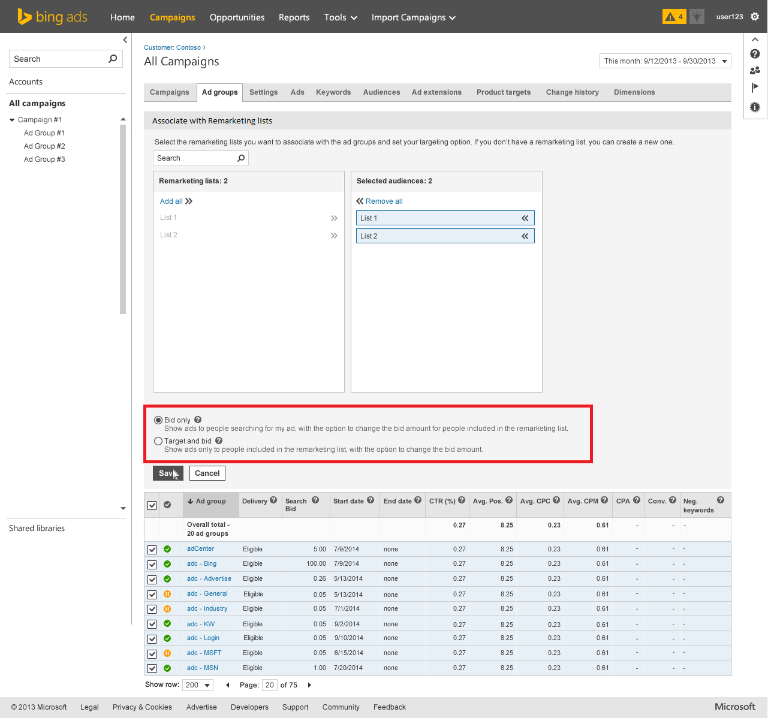
Note that you can also create associations (one ad group at a time) from the Audience tab as well. Click here to learn more.
4. Finally, all associations can be viewed and managed on the Audience tab in the campaigns page. You can set bid adjustments for each association via inline edit in the grid OR select multiple associations by using Edit> Change Bid Adjustment to set bid adjustments in bulk.
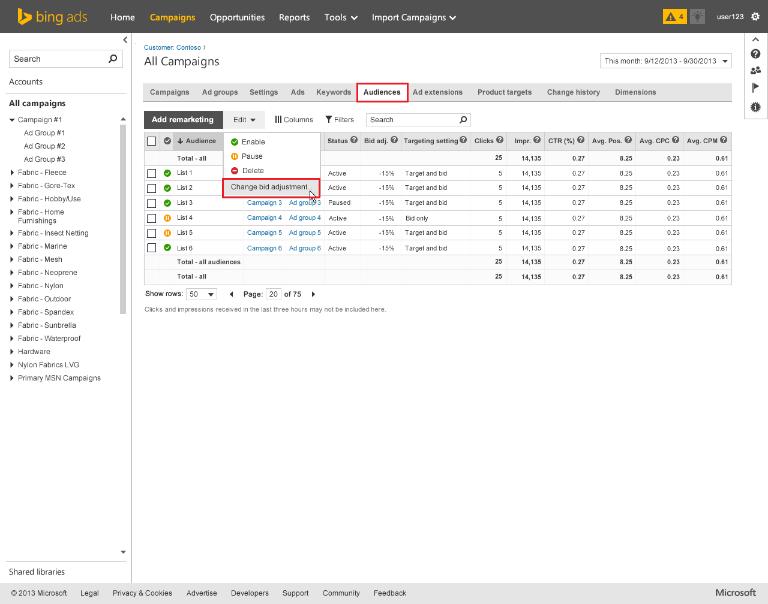
Note that you can view the performance (impressions, clicks, Spend, CTR, Conversions, Revenue etc.) of your remarketing campaigns in the Audience tab located on the campaigns page. We’ve also added a new Audience Performance report that can be download from the Reports tab in Bing Ads UI. The report supports both drill down association level reporting as well as aggregate campaign, account and remarketing list level reporting. This will also be enabled for API users.
How Does It All Work?
The UET tag tracking code on your website reports user activity to Bing Ads. We match this user activity with your definitions for the remarketing list. Users that have performed those matching actions will be added to the corresponding remarketing lists. A user may belong to multiple lists and one list can contain multiple users. When these users come return to perform search across our Network, Bing Ads will apply your campaign optimisations by associating relevant remarketing lists with ad groups. For more information, check out the Remarketing page here on the Bing Ads site.
Note that for privacy reasons, Bing Ads requires that your remarketing lists have at least 1000 users before the campaign optimisations can be applied those users.
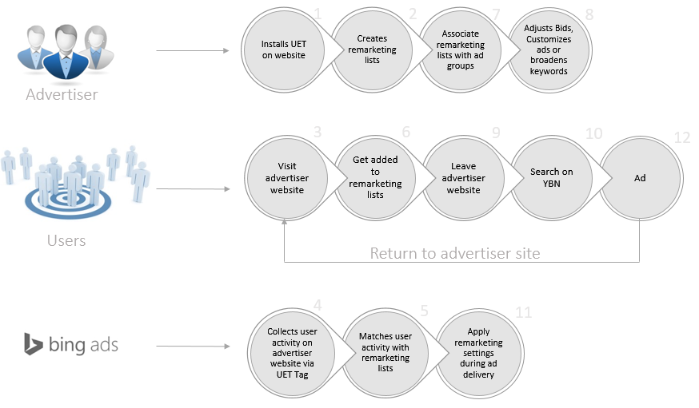
Please access your account today to get started with Remarketing. As you test things out, feel free to ping us on Twitter, suggest a feature on the Bing Ads Feature Suggestion Forum, or send us an email with your thoughts and feedback to: bingads-feedback@microsoft.com.